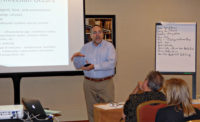On June 6 in Washington, the Plumbing Industry Leadership Coalition met to address three topics we’ve discussed in this column in recent months: upgrading the nation’s aging infrastructure, preparing for the federal law on no-lead plumbing products and attracting the next generation of plumbing industry professionals, including engineers.
Formed a year ago, PILC seeks to give the plumbing industry a unified — and stronger — voice on legislative matters and other important issues. Another goal is to improve the plumbing industry’s image. Both objectives are worthwhile.
PILC brings together the executives of associations representing engineers, contractors, distributors, code officials, water quality specialists, labor and other professionals. Key leaders of the group are Jim Kendzelof ASPE, Russ Chaney of IAPMO and Barbara Higgens of Plumbing Manufacturers International.
Aging infrastructure:A spokesman for the American Society of Civil Engineers sought PILC’s support in its efforts to upgrade the nation’s infrastructure. Earlier this year, you’ll recall, ASCE gave the country’s infrastructure an overall grade of D+ in its report card, which it issues every four years. In categories that relate specifically to the plumbing industry, drinking water, wastewater and schools each earned a D grade, while energy received a D+.
While not discussed specifically during the PILC meeting, the Water Resources Development Act had received overwhelming bipartisan support a month earlier in the U.S. Senate and now is awaiting House approval. Included within WRDA is the Water Infrastructure Finance and Innovation Act, which would assist water utilities in replacing water pipes. WRDA has received broad support from construction industry groups, such as the American Water Works Association and PMI.
No-lead plumbing:Federal legislation that will ban the installation of leaded plumbing products in potable water applications will go into effect less than six months after the PILC meeting. Some meeting attendees expressed dismay that the government still has not issued rules on how the law will be enforced.
Shortly before the meeting, the EPA issued an 11-page draft document on frequently asked questions about the new law. It’s available at http://www.pmengineer.com/articles/90784-epa-releases-draft-faq-on-lead-law. Most of the FAQs address the manufacture, installation and retail sale of plumbing products. PILC agreed to submit a consensus response from PILC members by EPA’s June 21 deadline.
Workforce development:With construction activity increasing, the need to attract the next generation of plumbing engineers, contractors, wholesalers and other professionals is growing more evident. Nearly a quarter of industry executives surveyed recently by consultant FMI expect severe shortages of construction employees a year from now.
PILC members heard from Bryan Albrecht, president of Gateway Technical College in Racine, Wis., and Roger Tadajewski, executive director of the National Coalition of Certification Centers, which is an outgrowth of a partnership between Gateway and Snap-on Tools. They said their public/private training partnership represents a new model of technical training in the United States, and they enlisted PILC’s support in getting the plumbing industry more involved in their initiative.
The plumbing industry stands to benefit from the unified voice PILC can provide. Just as important in moving the industry forward, however, is the individual involvement of the members of the associations that PILC represents on issues such as infrastructure, no-lead plumbing and workforce development.



